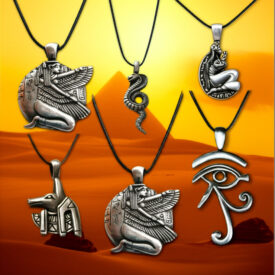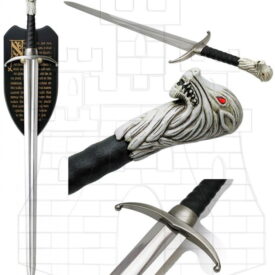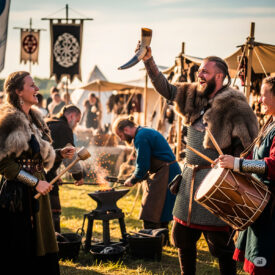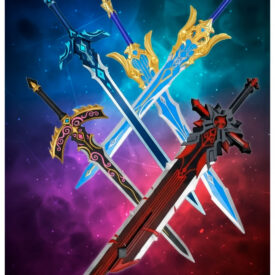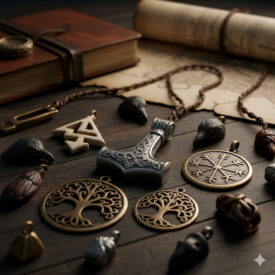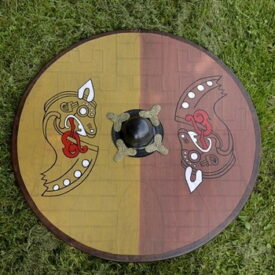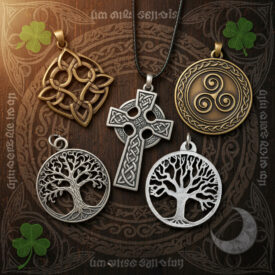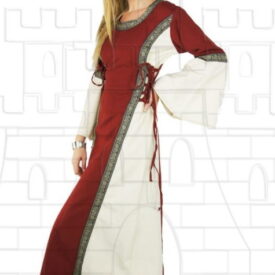In the heart of the Viking Age, women were not merely passive figures, but wielded power with fierce grace, inspired by goddesses who wove the fate of worlds. Do you dare to unravel the secrets these deities engraved in jewelry, transforming it not only into an adornment, but into an amulet of strength and status?
From the icy lands of Scandinavia to conquered shores, Viking pendants for women have transcended time, merging history, mythology, and an unmistakable style. In this epic journey, you will immerse yourself in the universe of designs inspired by Nordic goddesses, discovering how these pieces not only beautify but also narrate stories of love, war, fertility, and protection. Get ready to explore the symbology, materials, and fascinating evolution of these jewels that, now more than ever, resonate with feminine strength.
Nordic Goddesses: Historical Milestones and Symbolic Evidence
The documentation and symbolism associated with Nordic goddesses intertwine with archaeological findings, Viking art, and medieval literary compilations. Below is a chronologically ordered table summarizing key periods and symbolic evidence related to feminine deities such as Freyja, Frigg, and the Norns.
| Era | Event |
|---|---|
| Conceptual Origins (4th–7th Centuries AD) | |
| 4th–7th Centuries AD | First known runestones and use of the Elder Futhark (24 runes). Early runic associations link feminine concepts to runes: for example, Freyja with Fehu and Jera; Frigg with Perth; the Norns with Hagalaz and Nauthiz. These evidences indicate roots predating the Viking Age. |
| Viking Age and Artistic Boom (c. 790 – c. 1100; 8th–12th centuries) | |
| c. 790 – c. 1100 AD (Viking Age) | Development of Viking art and goldsmithing. Religious symbols and motifs are engraved on jewelry, weapons, and everyday objects; pieces related to feminine deities appear in funerary and domestic contexts. |
| 8th–12th centuries (Art and Goldsmithing) | Jewelry and ornaments evoking feminine motifs: designs with cat motifs (associated with Freyja) are relatively frequent in women’s graves. Thor’s hammer (Mjölnir) pendant, although masculine, frequently appears in women’s graves and is interpreted as a symbol of fertility and marital protection. |
| Written Documentation and Medieval Compilation (13th Century) | |
| 13th Century | Compilation of the Eddas in Iceland: the Poetic Edda and the Prose Edda (by Snorri Sturluson) record numerous myths of gods and goddesses—including Freyja, Sif, Frigg, and the Norns—offering the main medieval literary source on these figures. |
| Modern Reappropriation (1970s onwards) | |
| 1970s – present | Neopagan revival (Ásatrú and other movements) that worships Nordic deities such as Freyr/Freyja and Odin. Modern symbols (e.g., the Vegvisir) are reappropriated despite lacking direct Viking origin. |
| Feminine Symbolic Evidence (chronological summary by deity/theme) | |
| Freyja | Period: Viking Age (8th–12th centuries). Symbols: feline motifs and jewelry designs related to cats—more frequent in women’s graves—runic association with Fehu and Jera. Represents love, beauty, and fertility. |
| Frigg | Period: conceptualizations prior to the Viking Age (Elder Futhark) and mythological tradition documented in the Middle Ages. Symbols/attributes: Perth rune (rune 14) and Mannaz (humanity). Narratively related to the spear Gungnir in accounts showing her political/cultural intervention. |
| The Norns (Urðr, Verðandi, Skuld) | Period: documented in the 13th-century Eddas, although with earlier oral origins. Symbols: the weaving/tapestry of destiny (Web of Wyrd) and the House of the Norns at the roots of Yggdrasil. Runic associations: Urd with Hagalaz and Skuld with Nauthiz. |
| Thor / Mjölnir (link with feminine fertility) | Period: archaeological evidence of the hammer c. 800–900 AD. Symbolic use: Mjölnir acts as a protective amulet and symbol of fertility in marital contexts; frequently found in women’s graves and used in nuptial rituals (placement on the bride’s lap). |
| Nerthus / The Great Mother | Period: conceptualizations associated with the Elder Futhark. Symbols: Berkana rune (rune 18) linked to growth and fertility; archetypal representation of the Great Mother in pre-Christian Germanic tradition. |
The Echo of Goddesses in Viking Jewelry
Although the explicit representation of goddesses in Viking jewelry is sometimes subtle, their influence is undeniable. The designs were not only a reflection of their faith but also a manifestation of the status and identity of Viking women.Freya: Symbol of Love, Beauty, and Feminine Power
- Freyja’s Pendants
-
- Symbolism: Love, fertility, war, magic, beauty, and feminine power.
- Motifs: Cats (animals of her chariot), Brisingamen necklace.
- Association: Strength, femininity, harmony.
- Hel’s Pendants
-
- Symbolism: Underworld, cycles of life and death, acceptance of the unknown.
- Motifs: Dark aesthetic, mysterious elements.
- Association: Mystery, duality, inner strength.
Symbols of Feminine Strength and Protection
Beyond the goddesses, other potent Norse symbols were deeply significant for Viking women.
The Mjölnir: An Amulet of Fertility and Protection
 Although Thor’s Hammer, Mjölnir, is commonly known for its association with the strength and protection of its wearer, it was also a powerful symbol of fertility and consecration in Viking culture. It was used in matrimonial rituals, placed on the bride’s lap or in the nuptial bed to bless the union and ensure offspring. In archaeological excavations, more Mjölnir have been found in women’s graves than men’s, which suggests its particular importance for them.
Although Thor’s Hammer, Mjölnir, is commonly known for its association with the strength and protection of its wearer, it was also a powerful symbol of fertility and consecration in Viking culture. It was used in matrimonial rituals, placed on the bride’s lap or in the nuptial bed to bless the union and ensure offspring. In archaeological excavations, more Mjölnir have been found in women’s graves than men’s, which suggests its particular importance for them.
The Runes: Intrinsic Magic and Power
Runes, more than a mere alphabet, were considered bearers of magical powers and protection. Viking women engraved them on their jewels and amulets to invoke good fortune, protect themselves from harm, or enhance specific aspects of their lives. Here are some especially relevant runes:
- Berkana Rune: Known as the “Great Mother,” it represents fertility, growth, and home protection. It symbolizes a strong and protective woman, a bearer of life and new ideas.
- Laguz Rune: This feminine rune personifies vitality, intuition, and inner strength. It is a symbol of the determined and resolute woman, capable of flowing with life and adapting to its currents.
- Uruz Rune: Represents physical and mental strength, but in the feminine context, it is directly associated with fertility and resilience.
Other symbols of female empowerment:
In addition to the goddesses and runes, the Valkyries, those mythical warrior maidens who choose heroes fallen in battle, inspire pendants that symbolize courage and bravery. Yggdrasil, the world tree, symbolizes the universal connection between all beings and the nine realms, reminding us of our intrinsic connection with life itself.
Materials and Style: Forging Tradition with a Modern Touch
Today’s Viking pendants for women maintain the essence of the originals but adapt to modern sensibilities. The most common materials include:
- 925 Sterling Silver: Elegant and durable, silver offers a shine that enhances the beauty of the designs. It is the most widely used metal today to faithfully replicate Viking jewelry.
- Italian Bronze: With its warm and rustic tone, bronze evokes the authenticity of archaeological pieces, offering a more historical touch.
- Stainless Steel: A robust and modern option, ideal for those seeking durability and easy maintenance.
These materials are combined with goldsmithing techniques that respect Viking tradition, but with polished finishes and refined details that make them perfect for daily use. You can find designs ranging from the most intricate to the most minimalist, all laden with history and meaning.
Clearing doubts about Viking pendants
What are the most commonly used materials for making Viking pendants?The most commonly used materials for making Viking pendants were silver, bronze, gold, and iron. Silver was the most common metal, valued for its relative abundance and symbolism, while gold, being scarcer, was reserved for elite pieces. Bronze and iron were accessible to the general population and were also used in jewelry, albeit with less value than silver and gold. Additionally, materials like animal bones, amber, and dyed pebbles were occasionally incorporated into some designs.What Nordic symbols are most popular in Viking pendants?The most popular Nordic symbols in Viking pendants are:
- Mjölnir (Thor’s Hammer): Represents protection, strength, and courage; it was widely used by warriors and remains the most common symbol in Viking pendants.
- Valknut: Composed of three intertwined triangles, associated with the god Odin and death, it symbolizes the connection to the afterlife and strength in battle.
- Vegvisir: Also called the Viking compass, it symbolizes guidance and protection for overcoming difficulties.
- Aegishjalmur (Helm of Awe): Symbol of protection and victory over enemies.
- Yggdrasil: The world tree that represents the Norse cosmos and the connection between all worlds.
- Axe: Associated with the Viking warrior, it symbolizes strength and strategic thinking.
Other less frequent but also used symbols are the Svefnthorn (to make enemies sleep) and the Troll Cross (protection against dark magic). Among all, Mjölnir and Valknut are the most historical and popular in Viking pendants.How has Viking jewelry evolved from ancient times to today? Viking jewelry has evolved from simple utilitarian and symbolic pieces in ancient times to a cultural and stylistic manifestation that remains current and reinterpreted today. Initially made with metals such as bronze, silver, and gold, and natural materials like bone and glass, Viking jewelry combined functionality, social status, and religious beliefs through symbols such as Thor’s hammer or the Valknut.During the Viking Age (793-1066 S.P.), jewelry integrated advanced techniques such as chip carving, filigree, and repoussé, in addition to incorporating cultural influences from conquered territories, which enriched its designs and complexity. Pieces evolved from simple to highly elaborate, reflecting refined art and a very marked symbolic narrative.Currently, Viking jewelry remains an appreciated style that respects its traditional symbols and ancestral techniques, but reinterpreted with contemporary materials and adapted to modern fashion, preserving its cultural and historical charge while becoming a current aesthetic expression.What influence do Norse goddesses have on Viking pendant designs?Norse goddesses have a notable influence on Viking pendant designs, albeit less prominently than symbols linked to male gods such as Thor or Odin. Female figures such as Freyja, goddess of love, fertility, war, and magic, inspire pendants that reflect aspects of protection, power, fertility, and magical elements, with their symbolism associated with femininity, abundance, and life.Viking pendants often incorporate mythological motifs and symbols, where goddesses represent essential facets of life and cosmology, and these symbols served as amulets with protective or spiritual meanings. Although male symbols (like Thor’s hammer, Mjölnir) are more common in jewelry, the imprint of Norse goddesses is present in designs and rituals that pay tribute to their power and presence in Viking culture, especially related to love, war, and magic (Seiðr), areas where Freyja clearly stands out.What are the differences between silver and bronze Viking pendants?The differences between silver and bronze Viking pendants are mainly materials, durability, and aesthetics.Material and composition:
Viking jewelry has evolved from simple utilitarian and symbolic pieces in ancient times to a cultural and stylistic manifestation that remains current and reinterpreted today. Initially made with metals such as bronze, silver, and gold, and natural materials like bone and glass, Viking jewelry combined functionality, social status, and religious beliefs through symbols such as Thor’s hammer or the Valknut.During the Viking Age (793-1066 S.P.), jewelry integrated advanced techniques such as chip carving, filigree, and repoussé, in addition to incorporating cultural influences from conquered territories, which enriched its designs and complexity. Pieces evolved from simple to highly elaborate, reflecting refined art and a very marked symbolic narrative.Currently, Viking jewelry remains an appreciated style that respects its traditional symbols and ancestral techniques, but reinterpreted with contemporary materials and adapted to modern fashion, preserving its cultural and historical charge while becoming a current aesthetic expression.What influence do Norse goddesses have on Viking pendant designs?Norse goddesses have a notable influence on Viking pendant designs, albeit less prominently than symbols linked to male gods such as Thor or Odin. Female figures such as Freyja, goddess of love, fertility, war, and magic, inspire pendants that reflect aspects of protection, power, fertility, and magical elements, with their symbolism associated with femininity, abundance, and life.Viking pendants often incorporate mythological motifs and symbols, where goddesses represent essential facets of life and cosmology, and these symbols served as amulets with protective or spiritual meanings. Although male symbols (like Thor’s hammer, Mjölnir) are more common in jewelry, the imprint of Norse goddesses is present in designs and rituals that pay tribute to their power and presence in Viking culture, especially related to love, war, and magic (Seiðr), areas where Freyja clearly stands out.What are the differences between silver and bronze Viking pendants?The differences between silver and bronze Viking pendants are mainly materials, durability, and aesthetics.Material and composition:
- Silver pendants are usually made of 925 sterling silver, a precious material recognized for its shine and corrosion resistance.
- Bronze pendants are made of a copper and tin alloy, more common in traditional pieces and with a darker, more rustic finish.
Durability and care:
- Silver is softer than bronze, so it can scratch more easily but has better rust resistance and maintains its shine if well cared for.
- Bronze is more resistant to bumps and scratches, but can develop a patina or verdigris over time, which some value for its authentic aged look.
Aesthetics and symbolism:
- Silver pendants usually have a more polished, elegant, and luminous finish, attractive to those looking for a stylized and shiny piece of jewelry.
- Bronze pendants offer a more historical, classic, and rustic touch, better evoking the original appearance of archaeological Viking pieces.
In summary, silver provides shine and elegance with good wear resistance, while bronze offers a more traditional, robust, and aged finish that connects with the historical authenticity of Viking culture.
| Material | Composition | Durability and Care | Aesthetics and Symbolism |
|---|---|---|---|
| 925 Silver | Sterling silver (92.5% pure silver, 7.5% other metals) | Softer, can scratch easily, resistant to rust, maintains shine with care. | Polished, elegant, luminous, stylized, and shiny finish. |
| Bronze | Copper and tin alloy. | More resistant to bumps and scratches, can develop patina/verdigris (authentic aged look). | Historical, classic, rustic touch, evokes archaeological authenticity. |
Viking pendants for women are more than an accessory. They are a link to a glorious past, a reminder of the power and resilience of the women of a legendary era. Each design carries the essence of goddesses and ancestral symbols, becoming a personal amulet that celebrates strength, beauty, and the connection to nature and destiny. By choosing one of these pendants, you not only acquire a piece of jewelry, but you carry a fragment of an epic story, a legacy that continues to inspire those who, like you, dare to embrace the Viking spirit.

